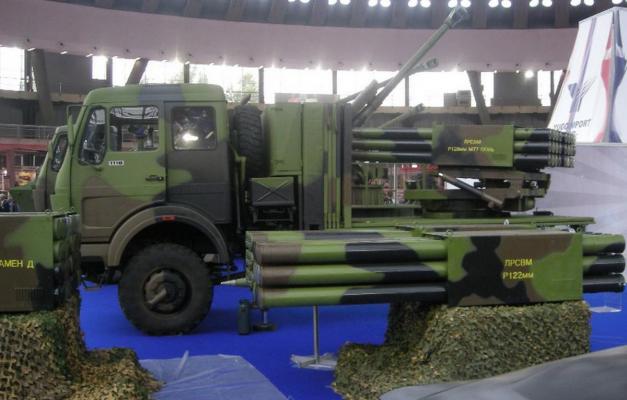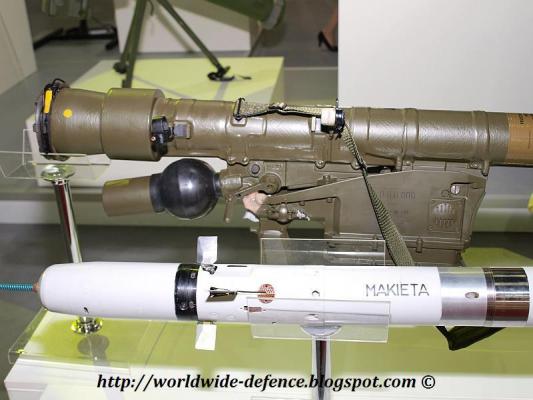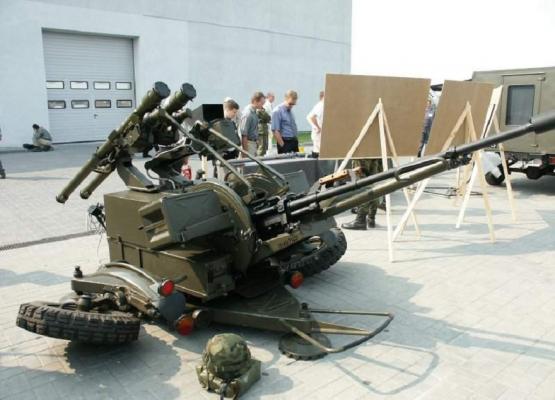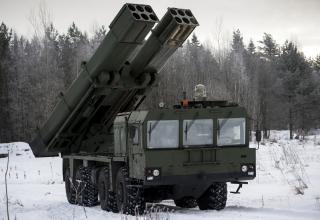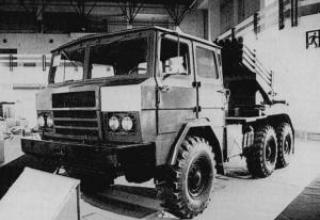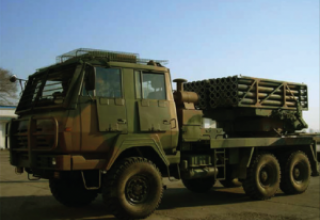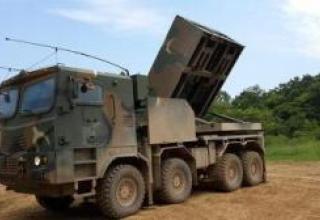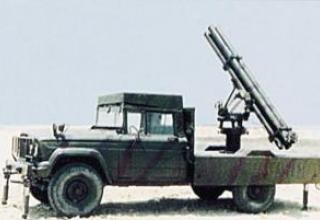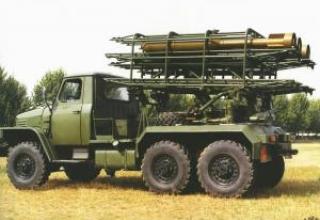The prototype of the LRSVM (Lanser Raketa Samohodni Višecevni Modularni) modular combat vehicle was developed by the specialists of the Military Technical Institute located in Belgrade (Serbia). Previously it was developed under the Lanser theme.
The development of the LRSVM was aimed at creating a modern universal system for firing various types of projectiles, different calibers or ranges.
The LRSVM has the following advantages:
- Polymorphism (a single platform for projectiles of different calibers and types of head parts);
- Modular design;
- Full automation of all functions of the combat vehicle;
- Integrated fire control system (IMS);
- Possibility of autonomous performance of assigned combat tasks;
- Efficient logistical support due to interchangeability of transport and launching containers.
The artillery unit may include interchangeable transport and launching modules (containers) for disposable or reusable use. The number of transport and launching containers on the platform is 2.
Number of guides for transport and launch containers:
- 16 - Plamen
- 12 - Oganj
- 12 - "Grad"
- 25 - for 107 mm caliber projectiles (see photo of the art part).
Depending on the type of TIC used, the following types of projectiles may be used:
- 128 mm Plamen A unguided rocket projectile with a range of 8.6 km;
- 128 mm unguided Plamen D rocket with a range of 12.6 km;
- 128 mm Oganj M77 unguided projectile with a range of 20.5 km;
- 122 mm Grad unguided rockets with a range of 35 km;
- 107-mm unguided rockets.
Guidance subsystems
- mainly by using an inertial navigation system;
- additionally by means of GPS or absolute encryption devices.
Time to prepare a task in a firing position: 45 seconds
Time to leave the firing position after the task has been completed: 30 seconds
The artillery part is mounted on the modified chassis of the Serbian vehicle FAP 1118 with 4x4 wheel configuration. The combat vehicle is equipped with a tent camouflage. It is possible to mount the artillery unit on other modified chassis, including armored ones (see design image of LRSVM variant on Serbian wheeled armored chassis SOKO).
The system can be used in conjunction with a modern fire control system.
Also see the gallery of prototypes of the Serbian LRSVM combat vehicle on our website.
Composition:
The portable version of the Grom complex is almost exactly the same as the Russian complex "Needle" in terms of composition and design.
It consists of:
- rockets;
- launch tube;
- launch mechanism with built-in radar requester and power supply unit.
The Grom rocket is made according to the aerodynamic scheme "duck", has aerodynamic rudders in the front part and four opening stabilizers in the rear. The homing head is two-channel, similar to 9E410. The photoreceiver of the main channel is made on the basis of the austenitic indium, and is cooled down to -196°C before starting. The photoreceiver of the auxiliary channel is an uncooled photoresistor on the basis of sulfur lead. The missile is operated in an airtight launch tube with sockets for connecting the launch mechanism and power supply unit. The reusable launch mechanism ensures automatic preparation of the rocket for launch, verification of its systems and firing. The power supply unit, designed to power the launch mechanism and the CNS cooling, consists of a cylinder with compressed nitrogen (35 MPa pressure) and a pyrotechnic battery.
Polish developers created a new contact fuse, modified the combat unit and the marching engine. As a result, the Grom complex was able to engage targets at altitudes of more than 3000m, the range of engagement increased to 5500m. The combat unit differs from the Russian prototype by a slightly higher weight and, according to the developers, is more effective. For the Grom complex there was also developed a new sensor of the IR3-02 state identification system.
Since 2006, the Military Technical Academy (Wojskowa Akademia Techniczna, Warsaw), together with BUMAR and ZM Mesko, has been developing an improved version of the Grom man-portable air defence system, designated Piorun ("Lightning"). The main goals of the program are to increase the missile speed, range and altitude of the target, to increase the interference immunity of the CNS, to provide the possibility of using the coplex against new classes of air targets, including unmanned aircraft. The combat unit is based on the new-generation high-energy explosive CL-20, is equipped with ready-made hit elements and a new non-contact fuse that can be programmed depending on the type of target. The weight of the combat unit has been increased by 10%. The Piorun man-portable air defence system will be able to engage targets flying at altitudes from 10m at speeds up to 400m/s. The probability of hitting a non-manoeuvring target is increased to 70%. The new man-portable air defense system is equipped with a night vision sight.
Man-portable air defense systems
The ZUR-23-2KG JODEK-G towed short-range anti-aircraft missile and artillery system (SAM) is used for air defense of military columns and stationary objects. The ZUR-23-2KG consists of two 23 mm 2A14 automatic guns, two GROM anti-aircraft missile launchers with a control panel (see photo), a cradle, upper carriage, a platform with chassis and electromechanical drives for azimuth and elevation angle. The unit is equipped with advanced CKE-2 sight, night vision device and laser rangefinder. The ZUR-23-2KG can destroy air targets moving at a speed of up to 300m/s at an altitude of up to 1500m and a range of up to 2500m, as well as engage manpower, light armoured vehicles and enemy fire points at a range of up to 2000m. The two-wheeled chassis with springs is mounted on support rollers. In combat position the wheels are raised and deflected to the side, and the unit is placed on the ground on three supporting plates (see photo 1, photo 2). Calculation of the complex - 4 people. The system is produced by the Polish company ZM Tarnow and has been in service since 2002.
Similar light ship turret ZU-23-2MP Wrobel-II ("Sparrow-II") is designed for organization of close air defense of ships of small displacement from the attacks of anti-ship missiles, aircraft and helicopters of the enemy. The upper part of the tower is made of transparent plastic, on which two containers with Grom missiles are placed (see photo). ZU-23-2MP complex is equipped with GP-02MR sight and can receive target designation from ship-based detection systems.
In September 2010 at the MSPO-2010 exhibition in Kielce was demonstrated a combat vehicle STAR 266M-OP Grom (Hibneryt-KG), designed by the 3rd district technical workshop (3 Okregowe Warsztaty Techniczne). The STAR 266M-OP Grom is a variant of placing the ZUR-23-2KG JODEK-G on the armored chassis of the STAR 266 off-road truck (see photo). The 6x6 vehicle is equipped with a diesel engine MAN D08824 LFG01 with an output of 114 kW. The driver and commander are located in the cab of the vehicle, and the other numbers of calculation (2 people) - in a special cabin, installed in the front of the body. The reservation provides protection against small arms fire, grenade fragments, mines and improvised explosive devices. The vehicle can transport up to 8 sets of Grom missiles. The new complex, which is positioned as multi-purpose, is intended for use by Polish armed forces during peacekeeping operations, including in Afghanistan.
ZM Tarnow has also developed a project to upgrade the Shilka anti-aircraft self-propelled unit. The upgraded ZM Tarnow (see photo) is equipped with a package of four containers of Grom anti-aircraft missiles, passive optoelectronic detection equipment with an automated target tracking system in day and night conditions, a digital ballistic computer, an advanced navigation system, improved communication and data transmission facilities, and a new electric generator. The complex, designated ZSU-23-4MP Biala, was adopted by the Polish Army in 2004. The ZSU-23-4MP is equipped with night vision systems for commander and driver, the crew reduced to three people.
On the basis of Grom anti-aircraft missiles CNPEP Radwar developed a mobile short-range anti-aircraft missile system Poprad. The Poprad complex is a self-contained PP-G platform (Platforma Przeciwlotnicza - Grom) with four launchers, optoelectronic detection system, laser rangefinder and IKZ-02 requestor of the Suprasl identification system of PIT-RADWAR company. The PP-G platform can be mounted on various media (see photo) and is equipped with a hydraulic lift, which, according to the developer, increases the efficiency of combat application and reduces the size of the combat vehicle in a camping position.
Tests of the Poprad complex started at the end of 2003 at the range of Dravsko Pomorsk, and the first launches in combat equipment were made in May 2004 at the range of Vitsko Morsk on the Baltic Sea coast. During the tests, the passive tracking system of the complex received target data provided by the mobile small-size three-dimensional MMSR radar operating in the E/F band.
Poprad SAM systems can be located at a distance of up to 40 km and receive target designation via radio channel from combat control vehicles WD-95 (later WD-2001), or directly from the MMSR radar.
The Kobra air defense system offered for export includes Poprad SAM systems and towed ZUR-23-2KG JODEK-G SAM systems. Each Kobra battery consists of six ZUR-23-2KG-1s, four Poprad SAM systems (see photo), a 3D MMSR S-band radar (see photo) and two WD-95 (WD-2001) command posts. All vehicles of the complex are placed on the chassis of Land Rover Defender 110.
Characteristics:
| Grom | Piorun | |
| Range of fire, m: - minimum - maximum |
500 up to 5500 |
500 up to 6000 |
| The height of the flight of the targets, m: - minimum - maximum |
10 3500 |
10 3600 |
| Flight Speed of the Affected Targets, m/s: - inhalation - towards |
320 400 |
|
| Probability of hitting a non-manoeuvrable target | 0.6 | 0.7 |
| Dimensions, mm: - caliber - length |
72 1648 |
72 - |
| Average flight speed, m/sec. | 580 | 660 |
| Weight in combat position, kg | 18.5 | - |
| Mass of the rocket, kg | 10.25 | - |
| Weight of combat unit, kg | 1.27 | - |
| The time to move to combat position, s | 13 | |
| Self-liquidation time, s | 14-17 | |
| Temperature range of combat application, deg | between -35 and +50 | |
Testing:
It should be noted that 14 years after the end of the Great Patriotic War, in the course of work on the development of the projectile engine for "remote mining", in his letter (out. 5/V 59) to the Director of Research Institute-582 State Committee of the Council of Ministers of the USSR on Defense Technology, Comrade S.I. Chichkov. (Balashikha 1, Moscow region), Deputy Director of Research Institute-147 (now FSUE "SNPP" Splav "(Tula) Alexander Nikitovich Ganichev reported: "...I recommend for the variant of an optic non-rotating projectile to use the launch rails for the projectile M-31 /BM-31-12/ which requires the diameter of the cassette to change to 300 mm".
